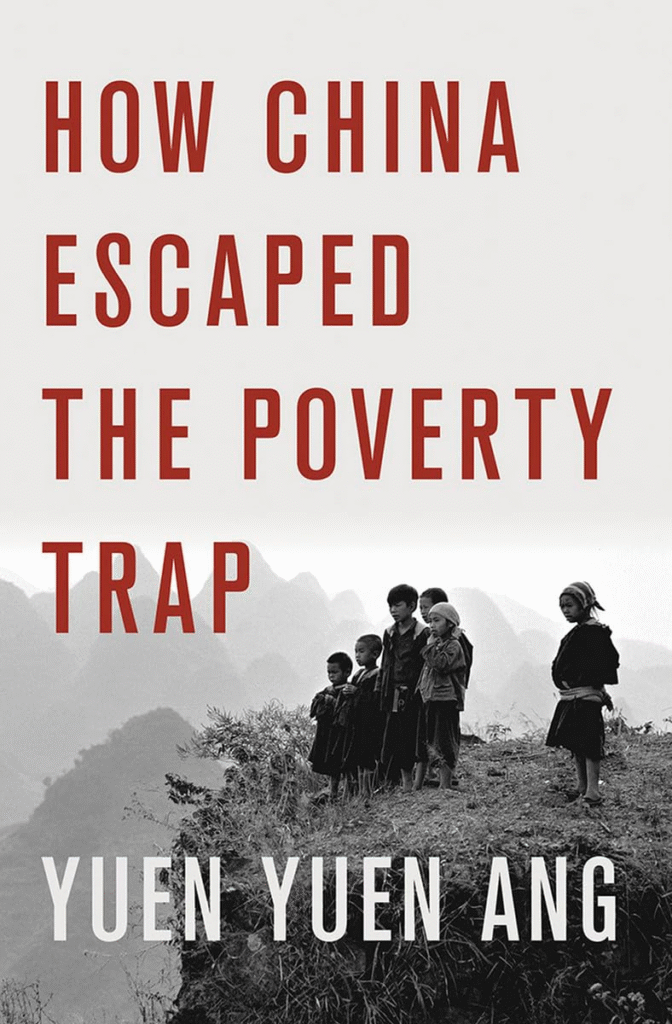How China Escaped the Poverty Trap by Yuen Yuen Ang is a groundbreaking and powerful book that explains how China, once a poor and struggling country, became one of the world’s fastest growing economies. Published in March 2022, the book challenges traditional ideas about how poor countries develop. Instead of following the usual advice like building strong institutions first or copying Western models, China took a different approach. Using the unique idea of directed improvisation, Ang shows how local officials were given the space to experiment and solve problems creatively while working under broad national goals.

How China Escaped the Poverty Trap by Yuen Yuen Ang is an award-winning and highly acclaimed book that offers a bold new perspective on how poor nations can break free from poverty. Recognized with top honors like the 2017 Peter Katzenstein Book Prize and the 2018 Zelizer Prize in Economic Sociology, it has been praised as a “game changer” by experts. Unlike traditional views that stress either strong institutions or early growth, this book introduces a fresh model that explains how China turned weak institutions into engines of economic progress. It challenges old assumptions and opens up a new way of thinking in development economics and political science.
Through more than 400 interviews with Chinese bureaucrats and entrepreneurs, the book shows how weak institutions were not barriers, but tools to kick-start markets. She explains that China’s success over 35 years did not come from strict central control, but from a smart mix of top-level direction and local level innovation, which she calls directed improvisation. This blend of national goals and local freedom helped poor regions grow quickly and turned China into a global economic force. Ang’s simple and clear analysis offers a new way to look at development. These early markets later helped build stronger institutions, creating a cycle of co-evolution. Ang argues that real development requires adaptive governance, where ground-level innovation and central guidance work together. This bottom-up approach helped China escape the poverty trap in just a few decades.
With a fresh theory rooted in complex systems rather than rigid economic rules, How China Escaped the Poverty Trap offers deep insights not only into China’s success but also into how other developing nations can build their own path to growth.
Read Also: Major Shaitan Singh Book Review by Jai Samota
Book Availability, Formats, and Pricing
How China Escaped the Poverty Trap by Yuen Yuen Ang was published on 15 March 2022 by Cornell University Press. The book is available in English and comes in 326 pages. It is offered in various formats: paperback priced at ₹1916, hardcover at ₹2236, and Kindle edition at ₹1705 and audiobook version is available free. The book can be purchased online through major platforms like Amazon India, Flipkart, and the Cornell University Press website. It is suitable for readers interested in development economics, China’s growth story, and political science.
Read Also: In Her Defence | Book Review | Gender Equality
About the Author of How China Escaped the Poverty Trap
Yuen Yuen Ang is an award-winning political scientist and author known for her powerful insights on development, governance, and the rise of China. Originally from Singapore, she earned her PhD from Stanford University and is currently a professor at Johns Hopkins University. Her research focuses on how countries can grow and reduce poverty without first having strong institutions. She is an Andrew Carnegie Fellow and the first-ever recipient of the Theda Skocpol Prize for Emerging Scholar, presented by the American Political Science Association.
In How China Escaped the Poverty Trap, Ang presents a new way of thinking about development, showing how China combined central guidance with local freedom to drive progress. Her work has earned global praise for being original, deeply researched, and practical for both scholars and policymakers.
She also wrote China’s Gilded Age, which explores how corruption and growth can coexist in fast-changing economies. With clear writing and fresh ideas, Yuen Yuen Ang continues to shape global conversations on political economy and reform.
Read Also: A Billion Butterflies | Jagadish Shukla
Thematic Analysis: How China Escaped the Poverty Trap
In How China Escaped the Poverty Trap, Yuen Yuen Ang presents a powerful rethink of how poor countries can grow. Instead of waiting for perfect institutions, China used what it had that is flexible rules, local leadership, and constant learning. Through real-world examples and sharp insights, the book explains how development can begin with existing conditions, evolve through practice, and succeed through local innovation. The following themes of book highlight the key ideas that made China’s growth model unique and effective.
- Directed Improvisation in China’s Rise: One of the most important themes in How China Escaped the Poverty Trap is the concept of directed improvisation. Instead of forcing local officials to follow a strict national plan, China gave them freedom to try their own solutions while still working toward national goals. This idea helped local leaders take real action, learn from experience, and adjust quickly. Yuen Yuen Ang explains how this flexible method worked better than rigid top-down systems and allowed new markets to grow in poor areas. This theme is key to understanding how China’s economic journey became so effective.
- The Role of Local Knowledge in National Growth: Another important message in How China Escaped the Poverty Trap is the power of local knowledge. China’s growth was not only driven by national policies, but also by the decisions and creativity of local officials who deeply understood their communities. By trusting local leaders to design solutions that fit their specific needs, China achieved more targeted and effective development. Ang argues that this decentralized, ground-up approach gave rise to handmade reforms and faster progress. For countries seeking sustainable development, this shows that respecting and using local insight can be just as valuable as high-level planning.
- Adaptive Governance in Action: How China Escaped the Poverty Trap highlights how China used adaptive governance to manage its development. This means the government was flexible, responded to local needs, and learned over time. Ang explains that instead of applying the same rule everywhere, China adjusted its policies depending on what worked in each area. This theme shows how smart, responsive governance can help a country deal with challenges and still grow. For readers and policymakers, this message is clear: good governance is not about being perfect, but about adapting and improving continuously.
- Growth Before Strong Institutions: In How China Escaped the Poverty Trap, Yuen Yuen Ang questions the long-held belief that strong institutions must come before economic development. Instead of fixing weak institutions first, China used them as stepping stones to launch markets. Local governments relied on informal practices like trust, relationships, and flexible rules to encourage business and investment. Over time, as markets expanded, institutions naturally evolved to support them. This “co-evolution” process shows that countries do not need perfect systems to start growing. Ang’s insight offers a powerful lesson for developing nations: real progress can begin with what already exists, even if it is imperfect.
- Decentralized Governance as an Innovation Engine: How China Escaped the Poverty Trap highlights the importance of decentralization in driving innovation. By giving local governments, the power to experiment with different strategies, China opened the door to diverse policy solutions. This led to successful practices spreading across regions. Ang argues that this kind of governance is not only important for China, but also valuable for other developing countries looking for flexible ways to grow.
- Adapting Institutions Through Practice: Yuen Yuen Ang’s book shows that institutions can evolve through practice, not just formal design. In early reform years, local Chinese officials used informal trust and personal ties to attract investment and promote development. Over time, these local practices helped build stronger institutions. How China Escaped the Poverty Trap gives a fresh view on how institutional change often follows success, rather than leading it.
- Learning Through Experimentation: Policy by Trial and Error: One fresh theme in How China Escaped the Poverty Trap is the idea that China’s reforms succeeded because they were experimental. Instead of trying to design perfect policies from the start, China encouraged local leaders to try different ideas and see what worked. Successful policies were then copied and scaled up. This “learning by doing” approach helped avoid large-scale policy failures and created space for innovation. Yuen Yuen Ang highlights how this method can be more effective than rigid planning, especially for developing countries that face unique and fast-changing challenges.
- High-Powered Incentives and Local Leadership: One of the key points in How China Escaped the Poverty Trap is how China used performance-based incentives to motivate local leaders. The government rewarded those who delivered results, especially economic growth. This system of rewards helped align local action with national goals. Ang explains how this model pushed officials to work hard and think creatively, showing how incentives can drive large-scale development.
- Rethinking Development Models for Poor Nations: Yuen Yuen Ang challenges the idea that there is only one path to development. How China Escaped the Poverty Trap offers a model that focuses on adaptability, local solutions, and evolving institutions. This message is important for other countries like Vietnam, Bangladesh, or Rwanda, which have followed their own unique development journeys. The book encourages a more inclusive way of thinking about economic success.
- Meta Institutions and Long-Term Change: In How China Escaped the Poverty Trap, the idea of “meta institutions” plays a powerful role. These are the systems that shape how other institutions work such as goal-setting, autonomy, and coordination. Ang shows how China’s meta institutions allowed for flexibility while keeping the country moving in a clear direction. This helped China manage both growth and complexity over time.
- Balancing Growth with Accountability: As China grew rapidly, new challenges like pollution and corruption emerged. How China Escaped the Poverty Trap ends with a deep reflection on whether the same system that fueled growth can now handle these problems. Ang suggests that the next phase of development must include stronger checks and more voice for local communities. Accountability and transparency may be China’s new challenges and opportunities.
- Flexible Bureaucracy as a Tool for Progress: One often-overlooked insight in How China Escaped the Poverty Trap is how China built a bureaucracy that was flexible, not fixed. Rather than locking officials into strict roles, the system encouraged adaptability and practical problem-solving. Yuen Yuen Ang describes how bureaucrats were expected to learn on the job, adjust to changing situations, and deliver outcomes and not just follow rules. This flexible approach helped China move quickly while avoiding common traps of rigid governance. The theme shows how a country can modernize without abandoning its unique political context, by making institutions responsive rather than resistant to change.
- Letting Development Outgrow the Rules: A powerful insight in How China Escaped the Poverty Trap is how China sometimes allowed growth to move faster than the rules. Yuen Yuen Ang explains that instead of trying to control everything with strict laws, the government sometimes allowed the economy to grow first and changed the rules later to catch up. This “rules follow growth” idea gave space for innovation. It is a unique part of the China development model that helped manage institutional change during rapid growth.
Why This Book Deserves Your Attention
Read Also: Amrita and Victor | Book Review | Ashwini Bhatnagar
How China Escaped the Poverty Trap by Yuen Yuen Ang is a must-read for anyone interested in development economics, policymaking, or China’s transformation story. Unlike traditional books that follow Western models, this one offers a fresh, real-world look at how a poor country used weak institutions and local innovation to achieve fast growth. Ang combines deep research with easy storytelling to explain how flexibility, experimentation, and grassroots action helped China rise. Whether you are a student, policymaker, or curious reader, this book will change how you think about progress, institutions, and how countries can grow on their own terms. It is not just about China instead it is a guide for all developing nations.
How China Escaped the Poverty Trap is written in clear, accessible English that balances academic insight with storytelling. Yuen Yuen Ang uses simple language to explain complex ideas, making it easy to understand even for readers without an economics background. The book combines theory with real-life examples from China’s local governments, giving it both depth and practical relevance. Ang’s writing is engaging and structured, with well-organized chapters that guide the reader step by step through China’s development journey. The book also includes charts, case studies, and detailed references, making it useful for students, researchers, and policymakers alike. It is both informative and thought-provoking, without being dry or overly technical.
Final Thoughts
How China Escaped the Poverty Trap by Yuen Yuen Ang offers a fresh, a bold and practical way to understand development. Instead of following the usual belief that strong institutions must come first, the book shows how China used weak institutions creatively to kickstart growth. Through local experiments, flexible governance, and adaptive learning, China built progress step by step. This book teaches us that development does not need to wait for perfect systems and it can begin with what exists. For policymakers, scholars, and curious readers, it offers an inspiring message: growth is possible when we focus on action, learning, and local solutions.
Read Also: The Hero of Tiger Hill | Kargil War Memoir




